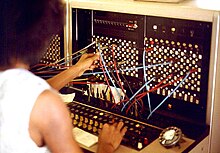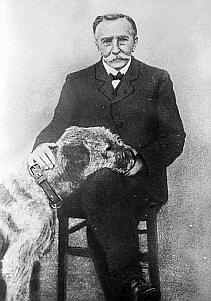
A telephone is a telecommunications device that permits two or more users to conduct a conversation when they are too far apart to be easily heard directly. A telephone converts sound, typically and most efficiently the human voice, into electronic signals that are transmitted via cables and other communication channels to another telephone which reproduces the sound to the receiving user. The term is derived from Greek: τῆλε (tēle, far) and φωνή (phōnē, voice), together meaning distant voice. A common short form of the term is phone, which came into use early in the telephone's history. Nowadays, phones are almost always in the form of smartphones or mobile phones, due to technological convergence.
In 1876, Alexander Graham Bell was the first to be granted a United States patent for a device that produced clearly intelligible replication of the human voice at a second device. This instrument was further developed by many others, and became rapidly indispensable in business, government, and in households. (Full article...)

A mobile phone (or cellphone) is a portable telephone that can make and receive calls over a radio frequency link while the user is moving within a telephone service area, as opposed to a fixed-location phone (landline phone). The radio frequency link establishes a connection to the switching systems of a mobile phone operator, which provides access to the public switched telephone network (PSTN). Modern mobile telephone services use a cellular network architecture, and therefore mobile telephones are called cellphones (or "cell phones") in North America. In addition to telephony, digital mobile phones support a variety of other services, such as text messaging, multimedia messaging, email, Internet access (via LTE, 5G NR or Wi-Fi), short-range wireless communications (infrared, Bluetooth), satellite access (navigation, messaging connectivity), business applications, payments (via NFC), multimedia playback and streaming (radio, television), digital photography, and video games. Mobile phones offering only basic capabilities are known as feature phones (slang: "dumbphones"); mobile phones that offer greatly advanced computing capabilities are referred to as smartphones. (Full article...)
A smartphone (often simply called a phone) is a mobile device that combines the functionality of a traditional mobile phone with advanced computing capabilities. It typically has a touchscreen interface, allowing users to access a wide range of applications and services, such as web browsing, email, and social media, as well as multimedia playback and streaming. Smartphones have built-in cameras, GPS navigation, and support for various communication methods, including voice calls, text messaging, and internet-based messaging apps. (Full article...)
Selected article -

A telephone switchboard was a device used to connect circuits of telephones to establish telephone calls between users or other switchboards, throughout the 20th century. The switchboard was an essential component of a manual telephone exchange, and was operated by switchboard operators who used electrical cords or switches to establish the connections.
The electromechanical automatic telephone exchange, invented by Almon Strowger in 1888, gradually replaced manual switchboards in central telephone exchanges around the world. In 1919, the Bell System in Canada also adopted automatic switching as its future technology, after years of reliance on manual systems.
Nevertheless, many manual branch exchanges remained operational into the second half of the 20th century in many enterprises. Later electronic devices and computer technology gave the operator access to an abundance of features. A private branch exchange (PBX) in a business usually has an attendant console, or an auto-attendant function, which bypasses the operator. (Full article...)Types of phones -

A courtesy telephone is a telephone located in airport terminals, large train stations, hotel lobbies, and other places where many travellers are expected, which is used to relay messages to a specific person.
It is typically used in connection with a public address system announcement of the style "Gwen Cooper, please pick up the nearest white courtesy telephone." Courtesy telephones may have a distinctive color, which is traditionally white in US airports, and most have no dialing capabilities but rather are simple ringdown stations to reach an operator or other fixed number. Some double as emergency telephones, having buttons by which a user can distinguish between emergency use and inquiry.
Customers can use a courtesy phone to seek information, such as where to find further transport or a person trying to meet them. Some courtesy phones provide a direct line to a number of advertised businesses, such as motels or taxis. They may be located near baggage claim, ticketing areas, and security checkpoints. (Full article...)Selected audio -
A disconnect tone in telephony is a tone provided to the remaining party to a call after the remote party hangs up. Typically, the disconnect tone is a few cycles of the reorder or busy tone (e.g. in US), or between five and fifteen seconds of the Number Unobtainable tone (e.g. in UK). (Full article...)
List articles

- Comparison of smartphones
- List of best-selling mobile phones
- List of countries by number of broadband Internet subscriptions
- List of countries by number of telephone lines in use
- List of countries by smartphone penetration
- List of country calling codes
- List of iPhone models
- List of mobile network operators
- List of mobile phone brands by country
- List of mobile phone generations
- List of telephone operating companies
Related portals
General images -
Selected biography

Charles Bourseul (28 April 1829 – 23 November 1912) was a pioneer in development of the "make and break" telephone about 20 years before Bell made a practical telephone.
Bourseul was born in Brussels, Belgium, and grew up in Douai, France. His father was a French army officer. Charles worked for the telegraph company as a civil engineer and mechanic. He made improvements to the telegraph system of L. F. Breguet (a French instrument maker) and Samuel F. B. Morse. Charles Bourseul experimented with the electrical transmission of the human voice and developed an electromagnetic microphone, but his telephone receiver was unable to convert electric current back into clear human voice sounds.
In 1854 Bourseul wrote a memorandum on the transmission of the human voice by electric currents that was first published in a magazine L'Illustration (Paris), though no prototype was built. That is about the same time that Meucci later claimed to have created his first attempt at the telephone in the United States of America. (Full article...)Selected images
Topics
Subcategories

More
 |
Here are some tasks awaiting attention:
|
Telephones in the news
No recent news
Associated Wikimedia
The following Wikimedia Foundation sister projects provide more on this subject:
-
Commons
Free media repository -
Wikibooks
Free textbooks and manuals -
Wikidata
Free knowledge base -
Wikinews
Free-content news -
Wikiquote
Collection of quotations -
Wikisource
Free-content library -
Wikiversity
Free learning tools -
Wiktionary
Dictionary and thesaurus
© MMXXIII Rich X Search. We shall prevail. All rights reserved. Rich X Search












































































































